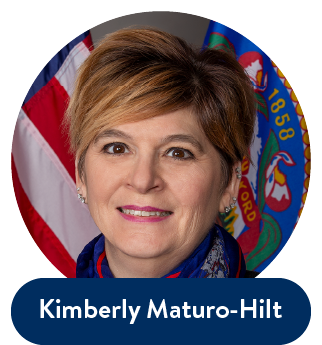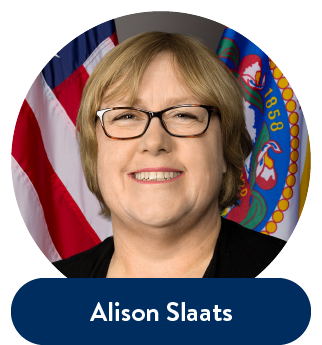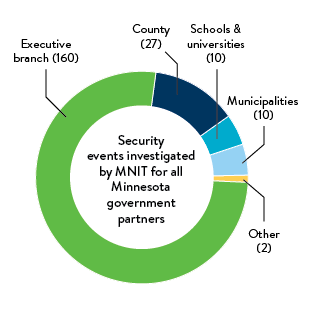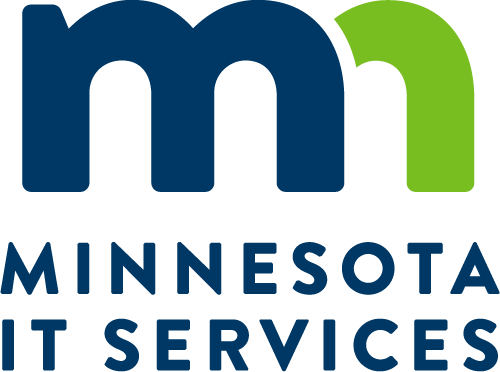Notable Achievements, Awards, and Events
Global Accessibility Awareness Day
MNIT’s Office of Accessibility celebrated Global Accessibility Awareness Day (GAAD) on May 19. GAAD gets everyone talking, thinking, and learning about digital accessibility. MNIT hosted a series of short presentations for State of Minnesota employees. The presentations showcased the value of accessibility and how accessibility improvements drive inclusion.
DNR awarded for public engagement tech
The Minnesota Department of Natural Resources (DNR) won the Tech Trailblazer Award during the 2022 Granicus Digital Government Awards. DNR used a new public engagement tool for their wolf plan update project. Engage with DNR broadened opportunities for feedback. MNIT DNR helped evaluate public engagement tools and put the solution in place.
MNIT launches cloud training challenge
MNIT launched a cloud training challenge as part of the state’s CloudRAMP (Cloud Readiness and Modernization Project) effort. Over 350 MNIT employees completed a fundamental cloud training course during the challenge period. 700 more employees are continuing their training after the challenge ended in July.
Transformation Practitioner’s Team
The Office of Transformation and Strategy Delivery created a change agent network called the Transformation Practitioner’s Team (TPT). The TPT helps state agencies navigate the Modernization Playbook and celebrated its 1st anniversary in June 2022. Learn how a few individuals on the TPT are using the Modernization Playbook to improve access to government services.
New MNIT Leaders
MNIT welcomed two leaders: Kimberly Maturo-Hilt and Alison Slaats. Maturo-Hilt is the Chief Business Technology Officer (CBTO) for MNIT partnering with the Minnesota Department of Veterans Affairs (MDVA). Alison Slaats is Minnesota’s Chief Geospatial Information Officer (GIO) and Director of the Geospatial Information Office (MnGeo). Read about these new leaders.


Emerging Technology: Application Portfolio
All of the state’s applications have a lifecycle and timeline. MNIT implemented a statewide application portfolio management process with a tool that helps us track applications’ lifecycle, business value, technical health, and much more. The tool helps the state make decisions about specific applications like whether or not to invest more in the application to improve its technical health, whether it is ready to move to the cloud, or whether it needs more planning in case of an emergency/disaster. MNIT uses this process to assess and analyze security risk, architecture standards, technology products, application cloud strategy, business capabilities, and more.
The tool also creates statewide visibility about all 2,400+ applications. MNIT built a data dashboard that gives executives a snapshot of the state’s application portfolio. The data ensures that we are making efficient and accurate decisions about applications – which help Minnesotans do everything from buying a fishing license, ordering tabs for their car, and receiving benefits as a veteran.
MNIT is also using the tool to consolidate types of applications and streamline processes. For example, if an agency learns that a customer relationship management (CRM) application is the type of application they need to solve a problem, they can use the new tool to see who else in the state is using a CRM application. We can modernize and consolidate tasks when we have the opportunity to do so.
Agency Updates
Office of Transformation and Strategy Delivery
Notable Projects
Frontline Worker Pay
The Frontline Worker Pay law provides bonus pay for eligible COVID-19 frontline workers who were employed in frontline sectors between March 15, 2020, and June 30, 2021. The Minnesota Department of Labor and Industry (DLI) opened the Frontline Worker Pay application from June 8 through July 22, 2022. MNIT, DLI, the Department of Employment and Economic Development, and the Department of Revenue quickly created an online application. It balanced fraud prevention, timely payments, and how easy it was for eligible people to receive payments. The application was built in less than six weeks. Over 1.2 million Minnesotans applied for the benefit. Applications were processed by the State in August 2022.
State Deed System Modernization
In May, MNIT and the Property Tax Division at the Department of Revenue launched a new form for counties to complete state deed applications for tax-fortified land. Tax-fortified lands are lands in Minnesota that have been forfeited for non-payment of the general real estate tax. Counties seeking deeds for these lands can now apply online and pay the application fees electronically. The new online form replaces a paper-based system for the 1,400 applications that the Property Tax Division processes each year. The new, streamlined process has reduced the time spent manually entering and correcting forms and provided a quicker, more efficient way for the counties to submit and pay the applications.
Electronic case reporting for COVID-19
MDH automated the extraction of COVID-19 case reports into the MDH surveillance system, which decreased workloads while maintaining the information's quality. The new electronic case reporting (eCR) process ensured timely and consistent reporting, which allowed MDH to have a better understanding of how COVID-19 impacted Minnesotans and the healthcare system.
MNIT created dashboards to view eCR messages by date of submission, healthcare organization, and encounter type. Using these dashboards, MDH can discover trends and changes in eCR messages at both broad and detailed levels. The process and evaluation of information collected by eCRs was recently published in the Journal of the American Medical Informatics Association (JAMIA), one of the first accepted papers on eCR from a public health agency.
Mobile application for DNR asset inventory
MNIT worked with the Minnesota Department of Natural Resources (DNR) to create a new application that DNR used to complete an annual inventory of the agency’s physical assets on a mobile device with a barcode scanner. The agency owns 15,000 assets – including aircraft, watercraft, vehicles, copiers, and more. The new application reduced the time it took to complete a full inventory at a DNR location. The streamlined process and intuitive, user-friendly application also result in a more accurate inventory.
MNIT and the DNR piloted the new application during the 2022 annual inventory. Over 70% of the DNR’s assets were inventoried in the new system. The agency expects to complete the entire inventory with the new application in 2023.
Exchanging death record data securely and efficiently
The COVID-19 pandemic increased demand for quicker access to accurate death data. MNIT and MDH modernized the way that data is exchanged – the interoperability – between the state’s database for registering and certifying births and deaths – Minnesota Registration & Certification (MR&C) – and the Southern Minnesota Regional Medical Examiner’s Office (SMRMEO) case-management system. MNIT created an open API so that SMRMEO staff could securely enter records in both their case-management system and the MR&C in one step.
This secure infrastructure establishes a way for future standards-based interoperability not only with other medical examiner offices but also with other partners involved in vital event data collection and registration across Minnesota. It also improves the timeliness, completeness, and accuracy of death records by removing dual data entry. SMRMEO metrics show that interoperability reduces staff time and minimizes the risk of registration errors.
Security
209 cybersecurity incidents detected by or reported to MNIT Security Operation Center within the Office of Enterprise Security.

| Type of security incident | # reported |
|---|---|
| Malware | 49 |
| Unauthorized Access Attempt | 3 |
| Forensic Investigation | 58 |
| Compromised Password | 36 |
| Network Attack/Scan | 6 |
| Denial of Service | 7 |
| Policy Violation | 11 |
| Copyright Violation | 8 |
| Social Engineering | 3 |
| Lost/Stolen Devices | 4 |
| Unauthorized Disclosure | 3 |
| Other | 21 |
Legislative Commission on Cybersecurity
On June 14, 2022, MNIT presented to the Legislative Commissioner on Cybersecurity. This bicameral body was established in 2021 to provide oversight of the whole of state’s cybersecurity measures. The commission reviews cybersecurity policies, challenges, and practices across all levels of government and may recommend policy changes to adequately protect the state from cybersecurity threats. The commission also may develop recommendations and draft legislation to support and strengthen the state’s cybersecurity infrastructure.
MNIT’s presentation (PDF) outlined current cybersecurity threats. MNIT also participated in a closed meeting, held under Minnesota Statutes, section 3.888, subdivision 5, and the commission’s Rules for Closed Meetings adopted on May 4, 2022. The closed meeting is meant to share information in a manner that is necessary to safeguard the state’s cybersecurity.
Procurement
| Type of Purchase | Number of purchase requests | Average processing time (days) |
|---|---|---|
| Equipment (hardware, software, etc.) | 236 | 8 |
| Facility management | 56 | 12 |
| Travel | 17 | 15 |
| Professional/technical contracts | 237 | 17 |
| Software | 887 | 13 |
| Staff management | 27 | 15 |
| Supplies | 45 | 12 |
| Training and development | 65 | 7 |
| Other | 94 | 11 |
| Purchase requests processed: 1,664 | Average purchase request processing time (days): 13 business days |
Geospatial Information Office
The Minnesota Geospatial Information Office coordinates geographic information systems (GIS) within the state, creating connections between state agencies and other stakeholders from government and non-government organizations.
30
Number of projects the MnGeo supports and hosts
997
Number of resources on the Minnesota Geospatial Commons
47
Orgs sharing their data on the Minnesota Geospatial Commons
24,297,422
Number of hits on the geospatial image server Q2 2022
Office of Accessibility
The Office of Accessibility is charged with overseeing the implementation of accessibility standards for all executive branch employees and state agencies.
724
Number of downloads of the Office of Accessibility’s guidance documents
185
Number of people who have taken or are taking the Accessible Word training course through the state employee training system, known as ELM
47
Orgs sharing their data on the Number of downloads of the Office of Accessibility’s quick cards
Service Desk
Our enterprise service desk provides 24/7 IT support and services for Minnesota state government: executive branch agencies, boards, councils, and commissions; non-executive branch customers, education, tribal governments, nonprofits; and MNIT staff.
107,270
Total volume of all service desk tickets across the executive branch
51,963
Number of those tickets resolved the same day
48.4%
Percentage of service desk tickets resolved in one day
4.6
Average rating of service desk interaction (1-5 scale)
IT Optimization Updates

CloudRAMP
This quarter, MNIT’s CloudRAMP (Cloud Readiness and Modernization Project) focused on learning how to prepare for successful migrations to the cloud. MNIT’s Enterprise Services division and the Minnesota Pollution Control Agency (MPCA) worked through the nuances of a repeatable process with the project team. They are creating new ways of working, training staff on new skills (cloud training challenge), and establishing a foundation for faster, collaborative development and work processes.
Modernized databases: 12
Migrated servers: 74
Meet MNIT: Peny Nguyen

Peny Nguyen was named the 2021 Employee of the Year during MNIT’s Annual Awards ceremony for her significant contributions to helping Minnesotans better understand the evolution and changing impact of COVID-19. As a financial analyst and data scientist with MNIT Finance, she used sophisticated data visualization tools to develop Minnesota’s COVID-19 vaccine dashboard. Nguyen’s pioneering work enables state agency executives to manage over $600M in annual IT resources using innovative analytic tools.
Nguyen started at MNIT in 2017. She has an MBA and a Bachelor’s degree in Economics from Hamline University.
About MNIT

Minnesota IT Services, led by the state’s Chief Information Officer, is the Information Technology agency for Minnesota’s executive branch, providing enterprise and local IT services to over 70 agencies, boards, and commissions. MNIT employs more than 2,000 people across 90 physical locations. Together, we build, maintain, and secure the State’s IT infrastructure, applications, projects, and services. MNIT sets IT strategy, direction, policies, and standards for enterprise IT leadership and planning. We also serve Minnesotans by connecting all 87 counties, 300 cities, and 200 public higher education campuses across the state on the MNET network. Through public-private partnerships, our team proactively protects the state’s information systems and the private data of 5.7 million Minnesotans.
Learn More
For questions, comments, and feedback on MNIT’s quarterly reports, please reach out to MNIT_Comm@state.mn.us.

